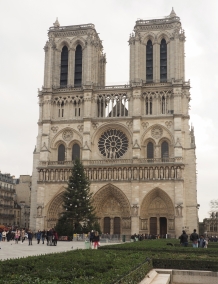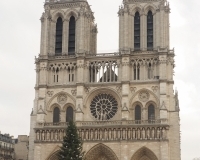Notre-Dame Cathedral (Notre-Dame de Paris)
The Notre-Dame de Paris, a masterpiece of medieval Gothic architecture is situated in the heart of Paris, on the Île de la Cité (Island of Cite).
Founded on a site which was once occupied by a Roman temple, the Cathedral of Notre-Dame de Paris was built in the period between 1163 and 1345. It is a grand basilica-type building with a transept and two towers, and large flying buttresses that support its high vaults and walls. The appearance of the main façade is shaped by three portals decorated with sculptures, the sculptural Gallery of Kings, a huge rose window, an arch gallery and two towers, each 69 meters tall. Despite the expression typical of the Gothic style, the appearance of the Notre-Dame de Paris features balance and harmony. The interior of the cathedral with five naves is strikingly sublime. It can simultaneously accommodate more than nine thousand people. The gallery on the second level can accommodate one and a half thousand people.
In the 18th century, the Island of Cite where the Notre-Dame de Paris is situated was covered by a net of narrow and crooked streets built up with tall medieval buildings that were in disrepair and were inhabited by the urban poor. The Cathedral was surrounded by buildings all around, and a tiny parvis space was only available near its main (western) façade. A small courtyard (cloître de Notre-Dame) surrounded by homes of canons of the cathedral was set up on the Northern side of the Cathedral. A group of medieval buildings constituting the residence of the Archbishop of Paris was closely adjacent to the Cathedral in the south.
During his visit to Paris, Peter I visited the Notre-Dame de Paris two times. On May 16/27, 1717, the Tsar returned from the Versailles for a reason, in order to attend a church festival. “He wanted to go to Paris in the morning to see a great ceremony which was attended by the Cardinal and Archevêques.” The Tsar was present on the gallery of the Cathedral during the Catholic feast of Corpus Christi. The solemn mass was led by the Archbishop of Paris, Cardinal de Noailles.
On June 3/14 (there was an error) after lunch, the Tsar climbed the Cathedral’s tower to admire a bird’s-eye view of Paris.
The French Revolution of the 18th century put the Cathedral at the risk of being demolished and turned it into the temple of the goddess Reason. It was re-consecrated by the date of the coronation of Napoleon I in 1802. In 1844 – 1864, the Cathedral was thoroughly restored by architect Viollet-le-Duc. In the mid-19th century, Baron Haussmann cleared the Island of Cite from dilapidated medieval structures to make the Notre-Dame de Paris visible from all sides.



